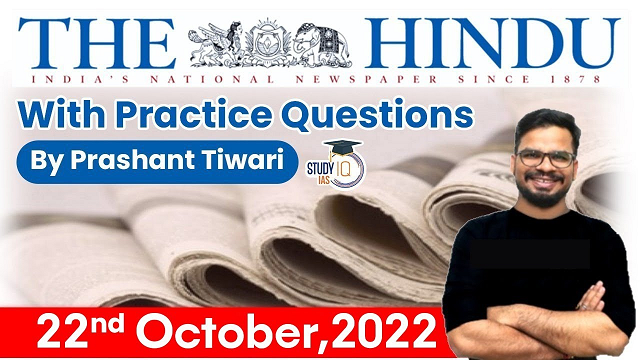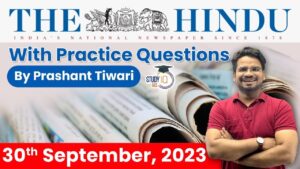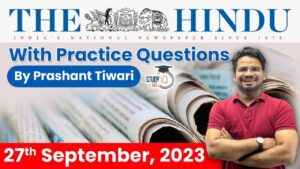The Hindu Newspaper Analysis for UPSC

The Hindu Newspaper Analysis 21 October 2022
- The Supreme Court on Friday said it is “tragic what we have reduced religion to” in the 21st century and a “climate of hate prevails in the country”, while directing the police and authorities to immediately and suo motu register cases against hate speech makers without waiting for a complaint to be filed.
- The court directed that first information reports (FIRs) should be registered and criminal proceedings initiated against the makers of hate speech “irrespective of their religion so that the secular character of the country is preserved”.
- Provisions regarding Hate Speech:
- Section 153A IPC penalises ‘promotion of enmity between different groups on grounds of religion, race, place of birth, residence, language, etc., and doing acts prejudicial to maintenance of harmony’.
- Section 153B IPC penalises ‘imputations, assertions prejudicial to national-integration’.
- Section 295A IPC penalises ‘deliberate and malicious acts, intended to outrage religious feelings of any class by insulting its religion or religious beliefs’.
- Section 298 IPC penalises ‘uttering, words, etc., with deliberate intent to wound the religious feelings of any person’.
- Section 505 IPC penalises publication or circulation of any statement, rumour or report causing public mischief and enmity, hatred or ill-will between classes.
- Part VII of the Representation of People Act, 1951 classifies hate speech as an offence committed during elections into two categories: corrupt practices and electoral offences.
- Viswanathan Committee 2019:
- It proposed inserting Sections 153 C (b) and Section 505 A in the IPC for incitement to commit an offence on grounds of religion, race, caste or community, sex, gender identity, sexual orientation, place of birth, residence, language, disability or tribe.
- It proposed punishment of up to two years along with Rs. 5,000 fine.
- Bezbaruah Committee 2014:
- It proposed amendment to Section 153 C of IPC (promoting or attempting to promote acts prejudicial to human dignity), punishable by five years and fine or both and Section 509 A IPC (word, gesture or act intended to insult member of a particular race), punishable by three years or fine or both.
The Hindu Editorial Today

Financial Action Task Force (FATF)?
- The FATF is an inter-governmental body that sets international standards seeking to prevent international financial crimes that aid terrorism.
- The FATF was established in July 1989 by a G-7 Summit in Paris, initially to examine and develop measures to combat money laundering.
Composition:
- The FATF currently comprises 37 member jurisdictions and two regional organizations (European Commission and Gulf Cooperation Council), representing most major financial centers in all parts of the globe.
- India has been a member of the FATF since 2010.
- India is also a member of its regional partners, the Asia Pacific Group (APG) and the Eurasian Group (EAG).
- Headquarters:
- Its Secretariat is located at the Organisation for Economic Cooperation and Development (OECD) headquarters in Paris.
- Lists under FATF:
- Grey List:
- Countries that are considered safe haven for supporting terror funding and money laundering are put in the FATF grey list.
- This inclusion serves as a warning to the country that it may enter the blacklist.
- Black List:
- Countries known as Non-Cooperative Countries or Territories (NCCTs) are put in the blacklist. These countries support terror funding and money laundering activities.
- The FATF revises the blacklist regularly, adding or deleting entries.
- Currently, Iran and Democratic People’s Republic of Korea (DPRK) are under High-risk Jurisdiction or black list.
- Grey List:


- The recent sighting of three Great Indian Bustards (GIBs) deep in Pakistan’s Cholistan desert has given rise to speculation that the endangered birds might have flown across the international border from India’s Desert National Park (DNP).
- GIBs are critically endangered in Pakistan because of lack of protection and rampant hunting.
- The GIB — the State bird of Rajasthan — is considered India’s most critically endangered bird and is protected under the Wildlife Protection Act. Its population of about 150 in Rajasthan accounts for 95% of its total world population.

- Habitat:
- Untamed, Arid grasslands.
- A Maximum number of GIBs were found in Jaisalmer and the Indian Army-controlled field firing range near Pokhran, Rajasthan.
- Other areas: Gujarat, Maharashtra, Karnataka and Andhra Pradesh.

- Last month, the Central Bureau of Investigation (CBI) conducted searches across States and Union Territories as part of a pan-India operation, “Megh Chakra”.
- The operation, against the online circulation and sharing of Child Sexual Abusive Material (CSAM) using cloud-based storage, was supposedly based on inputs received from Interpol’s Singapore special unit, in turn based on the information received from New Zealand.
- In November 2021, a similar exercise code-named “Operation Carbon” was launched by the CBI, with many being booked under the IT Act, 2000.
- In India, though viewing adult pornography in private is not an offence; seeking, browsing, downloading or exchanging child pornography is an offence punishable under the IT Act.
- In the Kamlesh Vaswani (WP(C) 177/2013) case, the petitioner sought a complete ban on pornography.
- After the Court’s intervention, the advisory committee (constituted under Section 88 of the IT Act) issued orders in March 2015 to ISPs to disable nine (domain) URLs which hosted contents in violation of the morality and decency clause of Article 19(2) of the Constitution.
- Article 19(1)(a): Freedom of speech and expression, provides every citizen with the right to express one’s views, opinions, beliefs, and convictions freely by word of mouth, writing, printing, picturing or in any other manner.
- Article 19(2) confers the right on the State to impose reasonable restrictions on the exercise of the freedom of speech and expression on the grounds of,
- Sovereignty and integrity of India,
- Security of the state,
- Friendly relations with foreign states,
- Public order, decency or morality,
- Contempt of court, defamation, and incitement to an offence.

- Days after the Union Environment Ministry announced a scheme to incentivise entrepreneurs to manufacture pellets from paddy stubble, beneficiaries say that the scheme does not account for the actual costs of manufacturing and is unlikely to help with reducing pollution from stubble burning.
- Pellets, which are manufactured out of agriculture biomass, when properly made would provide much more heat, emit fewer than 50% of the particulate matter and only a fraction of the ash from burning an equivalent amount of coal, according to Gurugram-based Amitabh Malaviya, who is in the business of pellet manufacturing.
Pelletisation:
- Paddy straw made into pellets that can be mixed along with coal in thermal power plants.
- This saves coal as well as reduces carbon emissions that would otherwise have been emitted were the straw burnt in the fields, as is the regular practice of most farmers in Punjab and Haryana.
Q) With reference to the Vulture population in India, consider the following statements:
- 96% of India’s vulture population declined between 1993 and 2003.
- Himalayan Vulture and Griffon Vulture are critically endangered.
Which of the above statements is/are correct?
- 1 only
- 2 only
- Both 1 and 2
- Neither 1 nor 2
भारत में गिद्धों की आबादी के संदर्भ में, निम्नलिखित कथनों पर विचार कीजिएः
- 1993 और 2003 के बीच भारत के गिद्धों की 96 फीसदी आबादी में गिरावट आई है।
- हिमालयी गिद्ध और ग्रिफॉन गिद्ध गंभीर रूप से संकटग्रस्त हैं।
उपरोक्त में से कौन सा/से कथन सही है/हैं?
- केवल 1
- केवल 2
- दोनों 1 और 2
- न तो 1 और न ही 2
Vulture population:
- 96% of India’s vulture population declined between 1993 and 2003.
- Therefore, the Central government put into place two action plans to protect the species at the national level — the first in 2006 and the second, ongoing plan for 2020-2025.
- One of the important action points in this nationwide plan is the formation of State-level committees to save the critically endangered population of vultures.
Vulture species in India:
- 9 species of vultures are found in India.
- Of these nine species, 4 are listed as Critically Endangered species of Vultures and one as endangered species in IUCN red list of endangered species.
Species of Vultures found in India and their Conservation Status:
- Indian Vulture or Long-billed vulture (Gyps indicus)- Critically Endangered
- Indian White-backed Vulture (Gyps bengalensis)- Critically Endangered
- Red-headed Vulture (Sarcogypscalvus)- Critically Endangered
- Slender-billed Vulture (Gyps tenuirostris)- Critically Endangered
- Egyptian Vulture (Neophronpercnopterus)- Endangered
- Cincerous Vulture (Aegypiusmonachus)- Near Threatened
- Bearded Vulture (Gypaetusbarbatus)- Near Threatened
- Himalayan Vulture (Gyps himalayansis)- Near Threatened
- Griffon Vulture (Gyps fulvus)- Least Concern
Q) With reference to the Mission LiFE (Lifestyle for Environment), consider the following statements:
- It was first proposed by the Prime Minister at COP 26, Mission LiFE.
- It envisioned as an India-led global mass movement that will nudge individual and collective action to protect and preserve the environment.
Which of the above statements is/are correct?
- 1 only
- 2 only
- Both 1 and 2
- Neither 1 nor 2
मिशन लाइफ (पर्यावरण के लिए जीवन शैली) के संदर्भ में, निम्नलिखित कथनों पर विचार करें:
- इसे पहली बार प्रधान मंत्री द्वारा COP 26, मिशन लाइफ में प्रस्तावित किया गया था।
- इसने भारत के नेतृत्व वाले वैश्विक जन आंदोलन के रूप में कल्पना की जो पर्यावरण की रक्षा और संरक्षण के लिए व्यक्तिगत और सामूहिक कार्रवाई को प्रेरित करेगा।
उपरोक्त में से कौन सा/से कथन सही है/हैं?
- केवल 1
- केवल 2
- दोनों 1 और 2
- न तो 1 और न ही 2
Explanation :
Prime Minister Narendra Modi recently launched Mission LiFE (Lifestyle for Environment), in the presence of the UN Secretary General António Guterres, at the Statue of Unity, Ekta Nagar, Gujarat.
- It was first proposed by the Prime Minister at COP 26, Mission LiFE.
- It envisioned as an India-led global mass movement that will nudge individual and collective action to protect and preserve the environment.
- The global movement will showcase sustainable goals and climate actions taken by countries and individuals around the world.
- It makes the fight against climate change democratic, in which everyone can contribute with their respective capacities.
- It aims at following a three-pronged strategy for changing people’s collective approach towards sustainability.
Q) With reference to the Single-use plastics, consider the following statements:
- Plastic carry bags of thickness less than 75 microns are prohibited under the Plastic Waste Management Rules.
- Plastic wrapping material less than 50 microns in thickness and plastic sachets used for selling and storing tobacco, pan masala and gutkha are allowed.
Which of the above statements is/are correct?
- 1 only
- 2 only
- Both 1 and 2
- Neither 1 nor 2
सिंगल यूज प्लास्टिक के संदर्भ में निम्नलिखित कथनों पर विचार कीजिएः
- प्लास्टिक कचरा प्रबंधन नियमों के तहत 75 माइक्रोन से कम मोटाई के प्लास्टिक कैरी बैग प्रतिबंधित हैं।
- 50 माइक्रोन से कम मोटाई की प्लास्टिक रैपिंग सामग्री और तंबाकू, पान मसाला और गुटखा बेचने और भंडारण के लिए उपयोग किए जाने वाले प्लास्टिक के पाउच की अनुमति है।
उपरोक्त में से कौन सा/से कथन सही है/हैं?
- केवल 1
- केवल 2
- दोनों 1 और 2
- न तो 1 और न ही 2
- In a bid to reduce plastic pollution, India from July 1, 2022 banned 19 SUP items.
- Plastic carry bags of thickness less than 75 microns are also prohibited under the Plastic Waste Management Rules. Their thickness will have to be increased to 120 microns from December 31, 2022.
- Plastic wrapping material less than 50 microns in thickness and plastic sachets used for selling and storing tobacco, pan masala and gutkha are also not allowed.
Q) ‘Global Financial Stability Report’ is prepared by the
- European Central Bank
- International Monetary Fund
- International Bank for Reconstruction and Development
- Organization for Economic Cooperation and Development
‘वैश्विक वित्तीय स्थिरता रिपोर्ट’ किसके द्वारा तैयार की जाती है?
- यूरोपीय सेंट्रल बैंक
- अंतर्राष्ट्रीय मुद्रा कोष
- पुनर्निर्माण और विकास के लिए अंतर्राष्ट्रीय बैंक
- आर्थिक सहयोग और विकास संगठन
Explanation:
- The Global Financial Stability Report (GFSR) is a semiannual report by the IMF that assesses the stability of global financial markets.
Q) Consider the following statements about the Intergovernmental Panel on Climate Change:
- It is an intergovernmental body of the United Nations.
- It was established in 1988 by the World Meteorological Organization (WMO) and the United Nations Environment Programme (UNEP).
- It is headquartered in Geneva, Switzerland.
Which of the statements given above is/are correct?
- 1 and 2 only
- 2 and 3 only
- 1 and 3 only
- 1, 2 and 3
जलवायु परिवर्तन पर अंतर सरकारी पैनल के बारे में निम्नलिखित कथनों पर विचार करें:
- यह संयुक्त राष्ट्र का एक अंतर सरकारी निकाय है।
- इसकी स्थापना 1988 में विश्व मौसम विज्ञान संगठन (WMO) और संयुक्त राष्ट्र पर्यावरण कार्यक्रम (UNEP) द्वारा की गई थी।
- इसका मुख्यालय जिनेवा, स्विट्जरलैंड में है।
ऊपर दिए गए कथनों में से कौन-सा/से सही है/हैं?
- केवल 1 और 2
- केवल 2 और 3
- केवल 1 और 3
- 1, 2 और 3
Explanation:
- The Intergovernmental Panel on Climate Change (IPCC) is an intergovernmental body of the United Nations responsible for advancing knowledge on human-induced climate change.
- It was established in 1988 by the World Meteorological Organization (WMO) and the United Nations Environment Programme (UNEP), and later endorsed by United Nations General Assembly.
- It is headquartered in Geneva, Switzerland, and is composed of 195 member states.
Mains Practice Question:
Q) “One of the most significant impacts of climate change is on our food system”. Explain (150 words)
“जलवायु परिवर्तन के सबसे महत्वपूर्ण प्रभावों में से एक हमारी खाद्य प्रणाली पर है”। समझाएं (150 शब्द)
Introduction:
- One of the most significant impacts of climate change is on our food system. It affects the way we produce as well as consume food. The impact is even more on a predominantly agrarian economy like India, creating ripple effects on the entire food production chain.
Body:
- The damage caused to agriculture and food security by the ongoing heatwave is multi-dimensional. It damaged the wheat crop, and affected the food supply, prompting a phenomenal rise in the price of wheat products.
- The loss to wheat is both qualitative as well as quantitative as besides the low output, the grain is also of poor quality.
- The Global Food Policy Report 2022 by the International Food Policy Research Institute has warned that climate change may push many Indians towards hunger by 2030 due to a decline in agricultural production and disruption in the food supply chain.
- “Higher temperatures, changing precipitation patterns, sea-level rise, and growing frequency and intensity of extreme weather events such as droughts, floods, extreme heat, and cyclones are already reducing agricultural productivity, disrupting food supply chains, and displacing communities,” the report noted.
- Another report by the UN Intergovernmental Panel on Climate Change (IPCC), Climate Change 2022: Impacts, Adaptation and Vulnerability, predicted that India’s high vulnerability and exposure to climate change is going to threaten food security and slow the country’s economic growth, besides impacting health and the overall development process, making poverty reduction even more difficult.
- India may not be facing an immediate famine, but policymakers have a task cut out.
- Climate change can reduce fresh water resources and food production.
- Climate change induced natural calamities can cause acute food insecurity Increase in drought may lead to agricultural labour migration, joblessness and persistent food insecurity.
Conclusion:
- Reimagining food systems requires looking at food systems through the prism of climate change adaptation and mitigation, which must also entail making them resilient to climate change and pandemics while making them green and sustainable.
Mains Practice Question:
Q) Discuss the significance of electoral literacy for a stronger democracy.(150 words)
एक मजबूत लोकतंत्र के लिए चुनावी साक्षरता के महत्व पर चर्चा करें।(150 शब्द)


 The Hindu Newspaper Analysis 6 October 2...
The Hindu Newspaper Analysis 6 October 2...
 The Hindu Newspaper Analysis 30 Septembe...
The Hindu Newspaper Analysis 30 Septembe...
 The Hindu Newspaper Analysis 27 Septembe...
The Hindu Newspaper Analysis 27 Septembe...





















